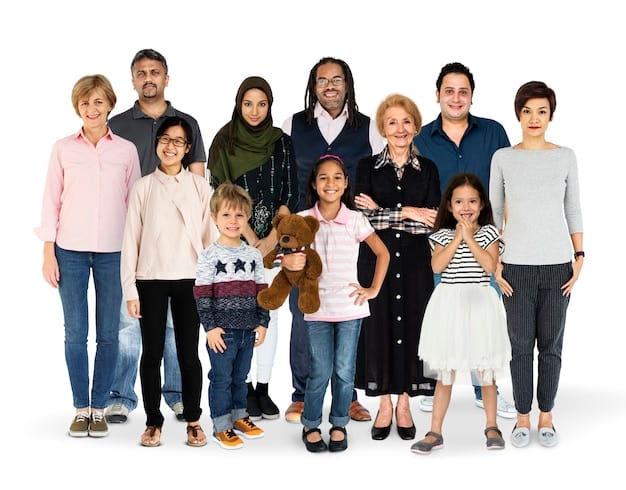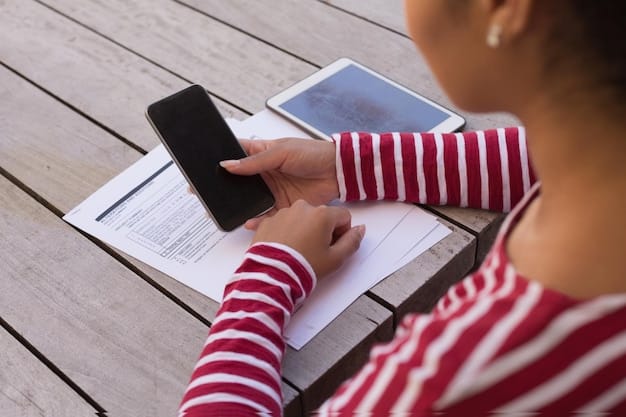Disaster Assistance: How to Get Help After a Natural Disaster in 2025

After a natural disaster in 2025, individuals can significantly benefit from federal, state, local, and non-governmental organization assistance programs, which offer financial aid, housing, medical support, and long-term recovery resources.
In the unpredictable landscape of natural disasters, understanding how to secure timely and effective support is paramount. As we look towards 2025, the complexities of disaster response and recovery continue to evolve, making it crucial for every household to grasp the mechanisms of Disaster Assistance: How to Get Help After a Natural Disaster in 2025. This guide aims to demystify the avenues of support, providing a clear roadmap to navigate the aftermath of an unforeseen event, ensuring you and your community can rebuild and recover.
Understanding the Federal Role in Disaster Response
When a natural disaster strikes, the immediate aftermath can be chaotic and overwhelming. In the United States, the federal government plays a pivotal role in providing comprehensive disaster assistance, primarily through agencies like the Federal Emergency Management Agency (FEMA). Understanding FEMA’s structure and the range of support it offers is the first step toward effective recovery.
FEMA acts as the central coordinator for federal disaster response efforts. Its mission is to support citizens and first responders to ensure that as a nation, those affected work together to build, sustain, and improve their capability to prepare for, protect against, respond to, recover from, and mitigate all hazards. This extensive mandate covers everything from pre-disaster preparedness initiatives to long-term community rebuilding and hazard mitigation projects.
Presidential Declarations and Their Impact
Federal disaster assistance is typically triggered by a presidential declaration, which can be either an emergency declaration or a major disaster declaration. These declarations unlock specific types of federal aid and resources for affected areas. An emergency declaration is issued for incidents that require federal assistance to supplement state, tribal, and local efforts to save lives, protect property and public health and safety, or lessen the threat of a catastrophe. A major disaster declaration is more extensive, providing a broader range of federal assistance programs for individuals and public infrastructure.
The type of declaration significantly influences the assistance available. For instance, a major disaster declaration often makes individuals eligible for the Individuals and Households Program (IHP), which provides financial assistance and direct services to eligible individuals and families who have uninsured or underinsured necessary expenses and serious needs directly caused by a disaster.
- Individual Assistance: Helps individuals and households with critical needs.
- Public Assistance: Reimburses states and local governments for disaster-related expenses.
- Hazard Mitigation: Funds projects to reduce future disaster risks.
Navigating these declarations and the associated programs can be complex. It’s essential for affected individuals to stay informed through official channels, such as local emergency management agencies and FEMA’s official website, to understand what type of declaration has been made for their area and what specific aid is accessible. Early engagement with these resources can significantly expedite the recovery process.
In essence, the federal government’s involvement is comprehensive, designed to support states, tribal nations, and local communities in managing the multifaceted challenges posed by natural disasters. This support evolves yearly, with legislative updates and policy changes aiming to streamline aid delivery and enhance community resilience against future events.
Navigating FEMA’s Individual and Households Program (IHP)
The Individuals and Households Program (IHP), administered by FEMA, is often the first line of defense for individuals and families facing the aftermath of a natural disaster. Understanding its components and eligibility criteria is crucial for anyone seeking federal financial aid and direct services. The IHP is designed to cover essential needs that are not met through insurance or other forms of assistance.
The IHP provides financial assistance and direct services for necessary expenses and serious needs. This can range from providing funds for temporary housing to repairing or replacing damaged homes. It’s not intended to make survivors whole but to meet basic needs and supplement existing resources.
What IHP Covers and How to Apply
The IHP is broken down into several categories of assistance, each designed to address specific needs. These include Housing Assistance, which provides financial help or housing solutions for those displaced from their homes, and Other Needs Assistance (ONA), which covers a broader range of disaster-related expenses. ONA can include funds for medical, dental, and funeral expenses, as well as essential personal property, transportation, and childcare costs.
Applying for IHP usually starts with registering with FEMA. This can be done online, by phone, or through the FEMA app. When registering, applicants will need to provide personal information, details about the damage, and insurance specifics. It’s critical to register as soon as possible after a disaster and to provide accurate and complete information to avoid delays.
- Housing Assistance: Rental assistance, lodging expenses, home repair, home replacement.
- Other Needs Assistance (ONA): Medical/dental, funeral, childcare, personal property, transportation, and other critical needs.
After registration, FEMA may schedule a home inspection to verify damages. Eligibility is determined based on various factors, including the type and extent of damage, insurance coverage, and pre-disaster living conditions. It’s important to remember that IHP is not a substitute for insurance but rather a safety net for uninsured or underinsured losses.
For those considering applying in 2025, it’s advisable to keep meticulous records of all disaster-related expenses, including receipts for repairs, temporary housing, and essential items. This documentation will be invaluable during the application process and any subsequent appeals. Furthermore, understanding the appeal process is vital, as initial denials can sometimes be reversed with additional documentation or clarification of circumstances.
The IHP is a vital resource for disaster survivors, offering a pathway toward stability. By understanding its scope and proactive engagement with the application process, individuals can significantly enhance their chances of receiving the aid necessary for a successful recovery.

State, Local, and Tribal Assistance Programs in 2025
While federal aid through FEMA is crucial, state, local, and tribal governments also play a significant role in providing disaster assistance. These entities often have unique programs tailored to the specific needs and vulnerabilities of their communities, complementing federal efforts. Understanding their contributions is essential for a holistic approach to disaster recovery.
State emergency management agencies work in tandem with federal authorities but also implement their own disaster relief initiatives. These can include financial assistance programs, housing support, and direct services that address gaps not fully covered by federal aid. Local governments, often through their emergency services departments, are typically the first responders and play a critical role in immediate relief efforts, such as setting up shelters and distributing essential supplies.
Leveraging Local Resources and Partnerships
Many states and localities administer programs designed to assist with housing needs, economic development post-disaster, and mental health support. For instance, some states have emergency funds for immediate housing repairs or temporary accommodation, while others offer low-interest loans for small businesses affected by a disaster. The activation of these programs often depends on the scale of the disaster and specific state or local legislation.
Tribal governments, as sovereign nations, also have their own disaster response and recovery mechanisms. They often work directly with federal agencies like FEMA, as well as state and local entities, to ensure their communities receive culturally appropriate and effective assistance. Their programs might focus on rebuilding tribal infrastructure, preserving cultural sites, and supporting traditional livelihoods affected by disasters.
- State-specific grants: Often for housing, small business recovery.
- Local emergency shelters: Immediate refuge and basic needs.
- Tribal community support: Culturally relevant aid, infrastructure rebuild.
Accessing these programs typically requires individuals to contact their state emergency management agency, local city or county government, or tribal authorities. Information about available aid is usually disseminated through official government websites, local news, and community centers. It’s advisable to know these local points of contact before a disaster strikes.
In 2025, there’s an increasing emphasis on integrated disaster planning, where federal, state, local, and tribal entities collaborate more closely to streamline assistance delivery. This includes shared databases for tracking needs and resources, joint training exercises, and unified command structures during response operations. This integrated approach aims to make the process of getting help less fragmented and more efficient for affected communities.
Therefore, while federal programs provide a robust foundation, the localized support offered by state, local, and tribal governments is fundamental to a comprehensive and resilient recovery. Individuals should proactively seek out information from all levels of government to maximize their access to available assistance.
Non-Governmental Organizations (NGOs) and Community Support
Beyond government agencies, a vast network of non-governmental organizations (NGOs) and community groups provide invaluable disaster assistance. These organizations often fill critical gaps in aid, offering immediate relief, long-term recovery support, and specialized services that might not be available through official channels. Their flexibility and community-rooted approaches make them indispensable partners in disaster response.
Major NGOs like the American Red Cross are often among the first to respond, providing immediate shelter, food, and emotional support. Other organizations, such as the Salvation Army, focus on distributing essential supplies like clothing, hygiene products, and cleaning kits. These groups operate largely on donations and volunteer efforts, demonstrating the power of collective humanitarian action.
Specialized Aid and Long-Term Recovery
Many NGOs specialize in particular areas of disaster relief. For example, some organizations focus on mental health support, offering counseling and psychological first aid to survivors. Others might concentrate on environmental restoration, assisting with the cleanup of debris or the rebuilding of damaged ecosystems. Organizations like Habitat for Humanity often engage in long-term housing reconstruction efforts, helping families rebuild their homes and lives.
Community-based organizations (CBOs) play a crucial role because they are intimately familiar with local needs and dynamics. They can reach vulnerable populations who might be overlooked by larger-scale efforts and provide culturally sensitive assistance. These groups often facilitate volunteer coordination, organize donation drives, and act as liaisons between affected residents and various aid providers.
- American Red Cross: Shelter, food, emotional support.
- Habitat for Humanity: Long-term housing reconstruction.
- Local Food Banks: Food security for displaced families.
To access assistance from NGOs, individuals can typically visit their websites, contact local chapters, or seek information at community shelters and disaster relief centers. Many NGOs collaborate closely and coordinate their efforts to ensure aid is delivered efficiently and without duplication. It’s not uncommon for multiple organizations to work together, each contributing their specific expertise to the recovery process.
In 2025, the role of NGOs is expected to grow, particularly in addressing the complex and prolonged recovery needs that often follow major disasters. With climate change leading to more frequent and intense events, the demand for sustained community support, infrastructure rebuilding, and emotional well-being services will only increase. Their adaptability and commitment to grassroots efforts make NGOs vital components of any comprehensive disaster assistance framework, providing hope and practical help when it’s needed most.
Insurance and Financial Planning for Disasters in 2025
While government and NGO assistance are vital, insurance and proactive financial planning remain the cornerstones of individual disaster preparedness and recovery. Relying solely on external aid can leave significant gaps, making a robust personal financial strategy essential. Understanding various insurance types and financial considerations in 2025 is key to securing your future resilience.
Standard homeowners’ insurance policies typically cover damages from perils like fire, wind, and hail, but often exclude floods and earthquakes. This is a critical distinction that many homeowners overlook until it’s too late. Flood insurance, for instance, is usually purchased separately through the National Flood Insurance Program (NFIP) or private insurers, especially in high-risk areas.
Supplemental Insurance and Emergency Funds
Given the increasing frequency and intensity of natural disasters, considering supplemental insurance becomes ever more important. This could include earthquake insurance, specific coverage for landslides, or even business interruption insurance for small business owners. Consulting with an insurance agent to review your current policies and assess potential vulnerabilities is a wise investment of time.
Beyond insurance, building an emergency fund is a non-negotiable aspect of disaster preparedness. This fund should ideally cover at least three to six months of living expenses, providing a financial cushion for a range of unexpected events, including displacement, loss of income, or unforeseen expenses related to disaster recovery. Access to liquid funds can significantly reduce stress and facilitate quick decision-making in a crisis.
- Review policies: Ensure flood, earthquake, and other specific coverages are adequate.
- Build emergency fund: Aim for 3-6 months of living expenses.
- Document assets: Keep an inventory of belongings with photos/videos.
In 2025, there’s a growing trend towards financial resilience planning, encouraging individuals to consider a broader spectrum of financial tools. This includes establishing lines of credit, knowing how to access retirement funds if absolutely necessary (though often a last resort), and understanding the tax implications of disaster relief payments or insurance payouts. Keeping important financial documents in a safe, accessible, and ideally waterproof location, or securely backed up digitally, is paramount.
The digital age also brings new considerations for financial planning, such as secure online banking and digital payment methods that might be more reliable if physical infrastructure is compromised. Preparing a financial “Go-Bag” with copies of critical documents, some cash, and essential contact numbers further reinforces preparedness. Ultimately, proactive financial planning and comprehensive insurance coverage offer the strongest defense against the economic shocks of a natural disaster, complementing public and charitable assistance initiatives.

Long-Term Recovery and Mental Health Support
Recovering from a natural disaster extends far beyond immediate physical needs; it encompasses a complex and often lengthy process of rebuilding lives, livelihoods, and addressing the profound emotional and psychological impacts. Long-term recovery and adequate mental health support are just as crucial as initial emergency aid, ensuring that individuals and communities can truly heal and thrive post-disaster.
Physical reconstruction, such as repairing homes and public infrastructure, can take years. During this period, communities often face ongoing challenges like supply chain disruptions, labor shortages, and bureaucratic hurdles in securing permits and funding. Long-term recovery groups, often composed of local leaders, government representatives, and NGO partners, typically lead these sustained rebuilding efforts, developing strategic plans for sustainable restoration.
Addressing the Invisible Wounds of Disaster
The emotional and psychological toll of a disaster can be immense, manifesting as anxiety, depression, PTSD, and other mental health challenges. These “invisible wounds” often emerge weeks or months after the event, making long-term mental health support critical. Many organizations offer free or low-cost counseling services, support groups, and crisis hotlines specifically tailored for disaster survivors.
Access to mental health professionals familiar with disaster trauma is vital. Community mental health centers, local hospitals, and national organizations like the Substance Abuse and Mental Health Services Administration (SAMHSA) can provide resources and referrals. Schools often play an important role in supporting children affected by disaster, offering counseling and creating stable environments.
- Trauma counseling: Individual and group therapy sessions.
- Support groups: Peer-to-peer healing and shared experiences.
- Children’s programs: Specialized support for young survivors.
In 2025, there’s an increased recognition of the need for integrated physical and mental health services in disaster recovery. This holistic approach aims to provide comprehensive care that addresses both the visible and invisible scars of a disaster. Initiatives focus on building mental health literacy within communities, reducing stigma around seeking help, and ensuring that psychological support is seamlessly woven into broader recovery strategies.
The road to full recovery is a marathon, not a sprint. It demands patience, resilience, and sustained access to resources. By prioritizing both physical and mental well-being, individuals and communities can navigate the complex path of long-term recovery, emerging stronger and more prepared for future challenges. This sustained support system ensures that the healing process is comprehensive, reaching every aspect of a survivor’s life.
Preparing for Future Disasters: Mitigation and Preparedness in 2025
Beyond recovering from past events, the most proactive step for individuals and communities is to seriously engage in mitigation and preparedness strategies. With climate change contributing to more extreme weather events, understanding and implementing effective preparedness measures in 2025 is no longer optional but a fundamental aspect of civic responsibility and personal safety.
Mitigation efforts aim to reduce the long-term risk to human life and property from hazards. This can involve structural changes, such as elevating homes in flood zones, reinforcing buildings against high winds, or implementing robust early warning systems. On a community level, mitigation includes land-use planning that avoids building in high-risk areas, restoring natural buffers like wetlands, and upgrading infrastructure to withstand future severe weather.
Individual and Community Preparedness Steps
For individuals, preparedness involves creating a comprehensive family disaster plan. This plan should include evacuation routes, designated meeting points, and communication strategies for family members, especially if separated. It’s crucial to practice this plan regularly so that everyone knows their role and what to do in an emergency.
As part of personal preparedness, assembling a well-stocked emergency kit is essential. This kit should contain at least three days’ worth of non-perishable food and water (one gallon per person per day), a first aid kit, flashlights with extra batteries, a whistle to signal for help, and any necessary medications. Documents such as insurance policies, identification, and a list of emergency contacts should also be included, preferably in a waterproof container.
- Family disaster plan: Outline evacuation routes, meeting points, communication strategy.
- Emergency kit: Essentials for at least 3 days (food, water, first aid, documents).
- Stay informed: Monitor local alerts, emergency broadcasts, and weather advisories.
Beyond individual efforts, community preparedness plays a vital role. This includes community-wide drills, public awareness campaigns, and fostering volunteer networks. Local emergency management agencies often provide resources, workshops, and information sessions to help residents prepare. Active participation in these community initiatives amplifies collective resilience.
In 2025, advancements in technology, such as AI-powered forecasting and real-time alert systems, are enhancing preparedness capabilities. Mobile apps and smart home devices can provide immediate warnings and personalized guidance during emergencies. Staying informed about these technological advances and integrating them into your preparedness strategy can significantly improve your safety and response effectiveness, making future disasters less devastating.
| Key Resource | Brief Description |
|---|---|
| 🏛️ FEMA | Federal agency coordinating disaster response and aid for individuals and public infrastructure. |
| 🤝 NGOs | Non-governmental organizations providing immediate relief and specialized long-term support. |
| 💰 Insurance | Crucial financial protection; review policies for flood/earthquake coverage. |
| 🧠 Mental Health | Support systems for addressing psychological impacts of a disaster. |
Frequently Asked Questions About Disaster Assistance
▼
The immediate first step after a safe assessment of your surroundings is to ensure your family’s safety and contact emergency services if needed. Then, register with FEMA for potential assistance, regardless of initial damage assessment. Document all damage with photos and videos for insurance claims later.
▼
You should apply for FEMA assistance as soon as possible after a presidential disaster declaration is made for your area. While there’s a deadline, early application ensures quicker processing and access to vital resources when you need them most, minimizing recovery delays.
▼
Yes, you can. FEMA assistance often supplements insurance. If your insurance doesn’t cover all your disaster-related needs or is delayed, FEMA may be able to provide aid for uninsured or underinsured losses and critical necessities not covered by your policy. Always file with your insurance first.
▼
Absolutely. Beyond immediate aid, numerous resources exist for long-term recovery. These include community rebuilding programs, ongoing mental health support, and financial counseling. Local long-term recovery groups, state agencies, and various NGOs often coordinate these extended efforts.
▼
You’ll typically need personal identification (SSN), contact information, banking details for direct deposit, insurance policy information, and a detailed description of your damages and losses. Keeping these documents readily accessible in a disaster kit can significantly streamline the application process.
Conclusion
Navigating the aftermath of a natural disaster can be one of life’s most challenging experiences, but it is not a journey you have to embark on alone. As we have explored, a robust and evolving ecosystem of support exists, designed to assist individuals and communities in their most vulnerable moments. From the critical federal assistance provided by FEMA and the tailored programs of state, local, and tribal governments to the invaluable humanitarian efforts of non-governmental organizations, help is available. Moreover, personal preparedness through comprehensive insurance and strategic financial planning forms an indispensable layer of defense, empowering individuals to take proactive steps toward their own resilience. The emphasis on long-term recovery and mental health support highlights a growing understanding that true healing extends beyond physical reconstruction, encompassing the invisible wounds of trauma. By understanding these diverse avenues of assistance and committing to robust preparedness measures, we can collectively face the future with greater confidence, ensuring that when disaster strikes, communities are not just rebuilt, but emerge stronger, more resilient, and better prepared for whatever may come.





